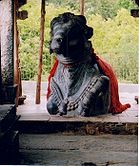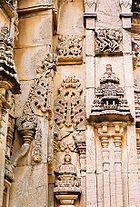
Doddabasappa Temple
Encyclopedia

Western Chalukya architecture
Western Chalukya architecture , also known as Kalyani Chalukya or Later Chalukya architecture, is the distinctive style of ornamented architecture that evolved during the rule of the Western Chalukya Empire in the Tungabhadra region of central Karnataka, India, during the 11th and 12th centuries...
innovation in Dambal, Karnataka
Karnataka
Karnataka , the land of the Kannadigas, is a state in South West India. It was created on 1 November 1956, with the passing of the States Reorganisation Act and this day is annually celebrated as Karnataka Rajyotsava...
state, India
India
India , officially the Republic of India , is a country in South Asia. It is the seventh-largest country by geographical area, the second-most populous country with over 1.2 billion people, and the most populous democracy in the world...
. The temple is about 20 km (12.4 mi) southeast of Gadag city and 24 km (14.9 mi) southwest of Ittagi in Koppal
Koppal
Koppal is a town in Koppal district in the Indian state of Karnataka. Koppal is surrounded on three sides by hillocks and was an important town in the history of Karnataka, popularly known as Kopana Nagar...
district. The sanctum contains a Shiva linga, the symbol of the presiding deity, God Shiva. The temple interior is a standard construction and consists of a sanctum (cella), a vestibule (antarala) and a main mantapa (also called navaranga or hall). The vestibule connects the sanctum to the mantapa. The Western Chalukya monuments, regional variants of existing dravida
Dravidian architecture
Dravidian architecture was a style of architecture that emerged thousands of years ago in Southern part of the Indian subcontinent or South India. They consist primarily of pyramid shaped temples called Koils which are dependent on intricate carved stone in order to create a step design consisting...
(South Indian) temples, defined the Karnata dravida architectural tradition.
Temple plan

Stellate plan
The temple is based on a very original 24-pointed uninterrupted stellateStellate
Stellate, meaning star-shaped, may refer to:* Stellate cell* Stellate ganglion* Stellate reticulum* Stellate veins* Stellate trichomes on plants* Stellate laceration or incisionWound#Open...
(star shaped) plan and uses soapstone
Soapstone
Soapstone is a metamorphic rock, a talc-schist. It is largely composed of the mineral talc and is thus rich in magnesium. It is produced by dynamothermal metamorphism and metasomatism, which occurs in the areas where tectonic plates are subducted, changing rocks by heat and pressure, with influx...
as its basic building material. Contemporary stellate plans of the Bhumija
Bhumija (architecture)
Bhumija is a variety of northern Indian Sikhara that is particularly popular in temples of western India, northern Deccan and the Malwa regions in India. It comprises a central latina projection, tapering towards the top on all four faces...
shrines in central India from where the inspiration for this temple came from, were all 32-pointed interrupted types. No temples of the 6-, 12-, or 24-pointed stellate plans are known to exist in Karnataka
Karnataka
Karnataka , the land of the Kannadigas, is a state in South West India. It was created on 1 November 1956, with the passing of the States Reorganisation Act and this day is annually celebrated as Karnataka Rajyotsava...
or Maharashtra
Maharashtra
Maharashtra is a state located in India. It is the second most populous after Uttar Pradesh and third largest state by area in India...
, with the exception of the Doddabasappa temple, which can be described as a 24-pointed uninterrupted plan. (In an 'interrupted' stellate plan, the stellate outline is interrupted by orthogonal
Orthogonality
Orthogonality occurs when two things can vary independently, they are uncorrelated, or they are perpendicular.-Mathematics:In mathematics, two vectors are orthogonal if they are perpendicular, i.e., they form a right angle...
(right-angle) projections in the cardinal direction
Cardinal direction
The four cardinal directions or cardinal points are the directions of north, east, south, and west, commonly denoted by their initials: N, E, S, W. East and west are at right angles to north and south, with east being in the direction of rotation and west being directly opposite. Intermediate...
s, resulting in star points that have been skipped.)

Pattadakal
Pattadakal is a village in Karnataka. It lies on the banks of the Malaprabha River in Bagalkot district. It is 22 km from Badami and about 10 km from Aihole...
is so extreme that it would be very difficult to find similarities without detailed examination. A star shape is obtained by rotating a square about its centre. The star points form equidistant projections. The angles and re-entrant angles thus formed make the perimeter of the outerwall of the shrine.
The star projections are carried right up the superstructure (tower over the shrine — Sikhara
Sikhara
Śikhara, a Sanskrit word translating literally to "mountain peak", refers to the rising tower in the Hindu temple architecture of North India. Sikhara over the sanctum sanctorum where the presiding deity is enshrined is the most prominent and visible part of a Hindu temple of North India.In south...
), giving it an exotic look, though it loses strength in comparison to the square superstructures found in conventional dravida plans. The storied arrangement of the superstructure found in dravida plans is not easily distinguishable here. The upper tiers of the seven-tiered (tala) superstructure look like cogged wheels with 48 dents.
Other details

Lakkundi
Lakkundi in Gadag District of Karnataka is a tiny village on the way to Hampi from Hubli. Lakkundi 11 km from Gadag in the east...
. The entrance to the shrine has above it a decorative architrave
Architrave
An architrave is the lintel or beam that rests on the capitals of the columns. It is an architectural element in Classical architecture.-Classical architecture:...
with space for images (now missing) of the Hindu
Hinduism
Hinduism is the predominant and indigenous religious tradition of the Indian Subcontinent. Hinduism is known to its followers as , amongst many other expressions...
Gods Brahma
Brahma
Brahma is the Hindu god of creation and one of the Trimurti, the others being Vishnu and Shiva. According to the Brahma Purana, he is the father of Mānu, and from Mānu all human beings are descended. In the Ramayana and the...
, Vishnu
Vishnu
Vishnu is the Supreme god in the Vaishnavite tradition of Hinduism. Smarta followers of Adi Shankara, among others, venerate Vishnu as one of the five primary forms of God....
and Shiva
Shiva
Shiva is a major Hindu deity, and is the destroyer god or transformer among the Trimurti, the Hindu Trinity of the primary aspects of the divine. God Shiva is a yogi who has notice of everything that happens in the world and is the main aspect of life. Yet one with great power lives a life of a...
. Depending on the dedication of the temple, either Vishnu or Shiva would take the central position in this arrangement. The entrance to the sanctum is elaborately decorated on either side with designs that are floral containing tiny images of dancers, musicians and even a mithuna couple (Gemini
Gemini (astrology)
Gemini is the third astrological sign in the Zodiac, which spans the Zodiac between the 60th and 89th degree of celestial longitude. Generally, the Sun transits this area of the zodiac between May 21 to June 20 each year...
). In the main mantapa (hall) there are three images, one of the "five headed" Brahma and his vehicle (vahana
Vahana
Vāhana denotes the being, typically an animal or mythical entity, a particular deva is said to use as a vehicle. In this capacity, the vāhana is often called the deity's mount. Upon the partnership between the deva and his vāhana is woven much iconography and mythology...
), the goose, and two images are of Surya
Surya
Surya Suraya or Phra Athit is the chief solar deity in Hinduism, one of the Adityas, son of Kasyapa and one of his wives, Aditi; of Indra; or of Dyaus Pitar . The term Surya also refers to the Sun, in general. Surya has hair and arms of gold...
, the Sun God.
The temple has two doorways each with a porch, one facing south and the other facing east. The east facing door has on either side the remains of what must have been elegant lintel
Lintel (architecture)
A lintel can be a load-bearing building component, a decorative architectural element, or a combined ornamented structural item. It is often found over portals, doors, and windows.-Structural uses:...
decoration, and an open hall type of pillared extension containing a large recumbent image of Nandi (bull) which faces the shrine.


